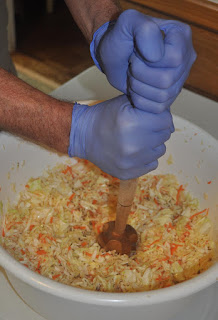So, I was hooked on smoothies. I began to fill my freezer with bananas to make them with. But the bananas didn't keep very well in the freezer. After a week or so, they would start to turn brown and take on a bitter aftertaste. I was only able to freeze about a weeks worth of bananas at a time. But my busy life often distracted me from the banana freezing schedule and I would open the freezer with anticipation, only to be disappointed when I discovered we were out of frozen bananas... sigh...
.
** This is an important part of the process...always peel your bananas before you freeze them!** A friend of mine took my suggestion and froze some bananas for smoothies for the kids one summer. A few days later I got a call from her asking me what the trick was for getting the peels off the frozen bananas so she could use them... I said, peeling them before they went in the freezer was the trick... she didn't think that was funny. Once the bananas are ripe, set aside a few minutes to process them and get them into the freezer all at once. I like to have all the items necessary for the process close at hand, so that the peeled bananas are not exposed to the air for very long. I have found that using a Seal-a-Meal vacuum sealer is the optimal way to package bananas for the freezer. The thick plastic Seal-a-Meal bags help protect the fruit and the vacuum sealing eliminates browning due to oxidization. Depending on the size of the banana I break them into 2 or 3 pieces, (usually 2, that way I know that 2 pieces equals 1 banana when it is smoothie making time). I put 6-8 bananas in a bag, depending on the size of the bananas and pack them in tightly.
I date the bags so that I know which bananas to use first, since when I am about half way through my supply of bananas, I get more and start the ripening process,so there could be bananas from different dates in the freezer at one time. I make the bag large enough to accommodate 6-8 bananas tightly packed , leaving 2-3 inches of extra bag to be used when sealing the bag. ** I always reuse my Seal-a-Meal bags, since they are kind of expensive. I use them 2 or three times for bananas, washing and drying them carefully each time I empty a bag. The bag will hold less bananas per use, since you have to cut the bag open and then leave a few inches for sealing the next time it is used. When after they are too small for storing bananas, I use them for other things like leftovers, etc.**
The open edge of the bag goes into the channel of the Seal-a-Meal. The bag needs to be smooth so that there are no wrinkles that could cause it not to seal properly.
Lock down the handle on the right side and press the seal button. The vacuum will evacuate the air. Once all the air is removed from the bag and it is drawn up tight against the bananas, the heat strip will come on and heat seal the bag. At this point there should be no room between bananas and the whole bag should feel solid, with no wiggle room. When the bag is opened for use, I cut as close as possible to the strip where it was heat sealed, so the bag can be used again. Once opened I put the Seal-a-Meal bag inside a gallon sized freezer Ziploc-style bag, with the top folded over and all the air pressed out of the bags to prevent undue exposure to the air.
Place the bananas in the freezer, being sure to put the most recent bags on the bottom. So that the oldest bananas get used first.
I know that sounds like a lot of trouble, but it really takes far less time to do than it does to talk about it! The really nice thing is that when properly sealed, the bananas will last for months in the freezer and be just as sweet and nice as the day they were put in the freezer!
Now on to the good part... here are a few of my recipes for some simple, yet delicious smoothies!
This recipe is a summertime favorite. I freeze fruits that come out of our garden all summer so that I can pick and choose which fruits to go in it. This is great for making popsicles as well.
Whatever You've Got Fruit Smoothie
Makes a blender full which will serve 3-4 or will serve two and make a couple of trays of popsicles
2 bananas
1 handful frozen strawberries2 handfuls frozen mangoes or peaches
1 handful frozen or fresh blueberries, blackberries or cherries
enough fruit juice to make smoothie the desired consisitency 1 1/2- 2 cups. I use unsweetened pineapple juice or 100% fruit juice,(cranberry, cherry berry, pomegranate).
In blender put bananas, and mangoes and enough juice to blend, (start with 1/2 cup), once that is pretty well blended, add the rest of the fruit. Pour the juice through the hole in the lid and pulse to get the blender to chew through the fruit chunks. Continue to add juice until the blender has blended the berries into the bananas and mango and the blender is churning the mixture without any trouble. How much liquid you add is up to you, make it as thick or as thin as you desire. This is a great kid pleaser. The nice thing is that it is a great way to get more fruit into their diet with no complaint.
Almond Milk Shake
This serves one, but can be doubled and will still easily fit in the blender
1 large frozen banana or 1 1/2 bananas if small
1 large Medjool date, pitted and soaked in small amount of almond milk, (just enough to cover it)
1/2-3/4 cup unsweetened almond milk.
Optional: dash of cinnamon.
Place the bananas, almond milk soaked date(plus soaking liquid), and 1/2 cup of almond milk in the blender. Blend until all the pieces of banana and date are blended into a thick shake, at this point add optional ingredients if desired. Add more almond milk if you desire a smoothie that isn't quite so thick.
It thick and sweet and in my opinion tastes better than a milk shake. It is virtually guilt free, since it is made with fruit and unsweetened almond milk, so there is no dairy, or sweetener in it.
The next smoothie is my mid afternoon pick-me up. It has raw cacao which helps with leveling of blood sugar and is a good source of magnesium, as well as PEA the "feel good" neurotransmitter, Tryptophan and Serotonin. Raw cacao is beneficial to the cardiovascular system, antioxidants in the raw cacao have been clinically proven to literally dissolve plaque built up in the arteries which helps in reversing heart disease and causes naturally lower blood pressure. I also add Maca, the Peruvian "superfood", which increases energy, endurance and stamina and has 27 trace minerals including Selenium. It is instrumental in helping the body to regulate hormonal processes. It can be used to treat hormonal dysfunctions caused by menopause in women and andropause in men. It really helps to reduce my hot flashes, but I am careful to have this mid-afternoon, since it has a stimulating effect and can interfere with sleep if consumed too late. All that said, it is yummy and chocolaty, with a slightly nutty flavor. And like the other almond shake is raw, vegan, and pretty much guilt free.
Healthy, Raw, Chocolate Almond Shake
Blender will accommodate ingredients to serve two so this can easily be doubled
1-1 1/2 bananas
3/4 to 1 cup almond milk ( more or less to obtain desired thickness)
1 rounded tsp. organic raw cacao powder
1/2 tsp. organic Maca
Optional: splash of Monin Hazelnut flavoring syrup
Place 3/4 cup almond milk in blender, add other all ingredients and blend until smooth. Add more almond milk to obtain desired thickness.
Blog Hops This post is linked to:
http://www.growingpatch.com/blog-hop/
Homestead Barn Hop #100
HomeAcre Hop#8
Farmgirl Friday Blog Hop#97
Farmgirl BlogFest #22
Clever Chicks Blog Hop #23
Sustainable Suburbia
Country Homemaker Blog Hop #56
Hearthfelt Hopes Blog Hop#1
Frugally Sustainable Blog Hop#66











































